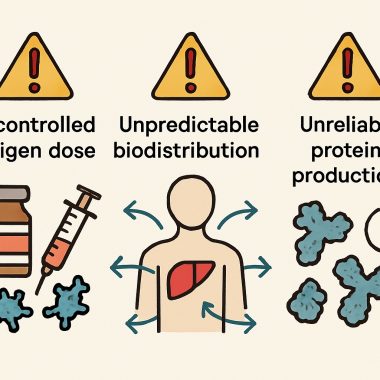Questions the Safety of mRNA Platform
In a revealing interview, Dr. Jay Bhattacharya, a renowned epidemiologist and the newly appointed director of the National Institutes of Health, shared alarming insights into the problems surrounding mRNA vaccine technology.
Tasked by Secretary Robert Kennedy to investigate causes of autism and review vaccine safety, Dr. Bhattacharya is gaining full access to NIH data—data that, according to him, is already confirming some of the worst fears about COVID-19 vaccines.
Although the whole dataset has not yet been publicly released, early findings suggest that the foundational assumptions behind mRNA vaccines were deeply flawed. Dr. Bhattacharya’s analysis sheds light on why public trust has collapsed and why he believes major scientific advances are still needed before mRNA technology can be safely used.
Public Trust in COVID Vaccines Has Collapsed
Dr. Bhattacharya began by noting the dramatic decline in COVID-19 vaccine uptake across the United States, which he attributes to growing concerns about the safety of mRNA vaccines.
Although some health authorities in the United Kingdom continue to recommend these vaccines, he found it positive that childhood vaccination rates in the U.S. remained relatively low. In the eyes of the American public, he says, COVID vaccines are now “effectively dead.”
The financial collapse mirrors the loss of trust. Companies like Pfizer and Moderna, once riding record profits from vaccine sales, have seen revenues plunge since 2021. While the public has largely moved on from COVID vaccinations, Bhattacharya warns that the risks posed by mRNA technology itself are far from resolved.
Three Core Problems with mRNA Technology

Drawing from the newly available NIH data, Dr. Bhattacharya outlined three major scientific flaws in how mRNA vaccines function: uncontrolled antigen dose, unpredictable biodistribution, and unreliable protein production.
First, he explained that while scientists can control how much mRNA they inject, they cannot control how much antigen—the immune-stimulating protein—is produced inside the body. Some people’s cells may produce small amounts, while others may churn out large quantities. Worse, spike protein production can persist for long periods in some individuals, undermining fundamental principles of safe dosing.
Second, there is no control over where the vaccine material travels once injected. Although intramuscular injection is supposed to keep the vaccine localized, in reality, the lipid nanoparticles carrying the mRNA spread widely throughout the body. They can reach vital organs like the brain, liver, heart, and eyes. This systemic spread explains why adverse reactions have been observed across multiple body systems.
Finally, even the proteins produced by the body may not be what scientists intended. Dr. Bhattacharya described a phenomenon known as “frameshifting,” where errors in reading the mRNA code can create unintended proteins. This manufacturing flaw raises serious concerns about long-term risks, including the theoretical possibility of prion diseases like Creutzfeldt-Jakob disease, a truly alarming prospect.
Nobel Prizes Were Awarded, But Major Flaws Remain
Dr. Bhattacharya pointed out the irony that the mRNA platform was honored with a Nobel Prize, even though critical problems persist. He believes it will take at least two or three more Nobel Prize-level scientific breakthroughs to resolve the existing safety issues before mRNA technology is ready for widespread medical use.
He stressed that regulators must confront an uncomfortable reality: they are approving products where the dose, the distribution, and even the molecular structure of the resulting proteins cannot be reliably controlled. From a medical ethics standpoint, this is a serious breach of long-standing standards requiring precise knowledge about a treatment’s behavior inside the body.
Time to Rethink the Mad Rush Toward mRNA Platforms
Despite the technology’s potential, Dr. Bhattacharya urged extreme caution. He argued that massive investment into expanding mRNA vaccine manufacturing around the world—especially in places like Australia, England, and Canada—should be paused. Until the significant uncertainties are resolved, continuing to push forward with mRNA platforms could endanger public health, a risk we cannot afford to take.
He warned that while the scientific community may eventually solve these issues, it is reckless to keep rolling out products before the technology is truly ready. Instead of pouring billions into facilities and new vaccine campaigns, Bhattacharya believes governments and corporations should wait for the necessary breakthroughs to occur.
A Call for Independent Regulatory Action
In closing, Dr. Bhattacharya placed responsibility squarely on independent health regulators. He challenged them to explain why they continue to authorize mRNA products when there is clear evidence of uncontrollable dosing, systemic distribution, and unpredictable antigen formation.
He expressed hope that scientific integrity would ultimately prevail, but he voiced concern that political and financial pressures could prolong the reckless use of mRNA vaccines. Unless the global medical community confronts these uncomfortable truths, Bhattacharya warned, we risk repeating the same mistakes—only on a larger, more dangerous scale.
The future of mRNA medicine remains full of potential, but if Dr. Bhattacharya’s warnings prove correct, it is still a long, arduous journey before that potential can be safely realized.









